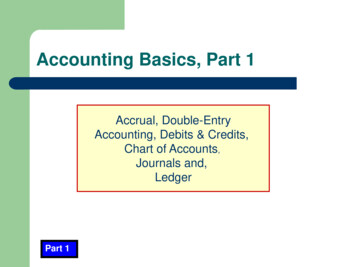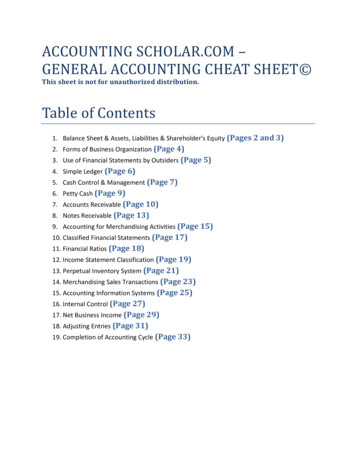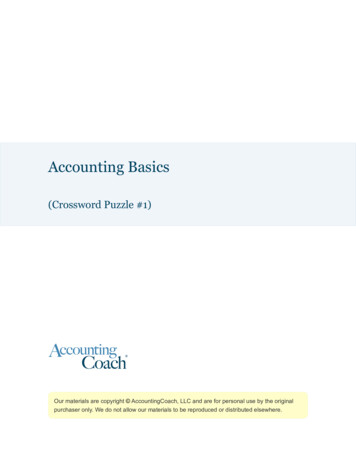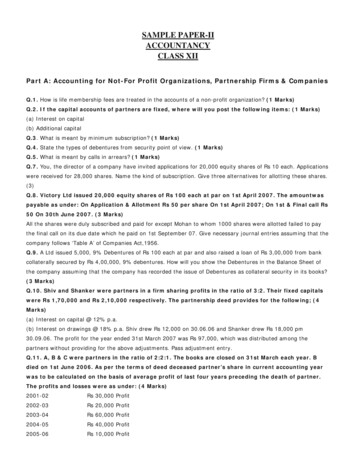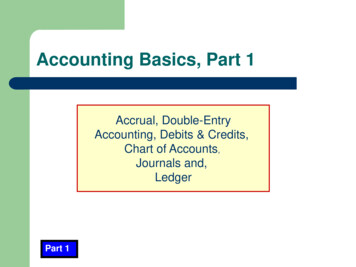
Transcription
Accounting Basics, Part 1Accrual, Double-EntryAccounting, Debits & Credits,Chart of Accounts,Journals and,LedgerPart 1
What’s Here IntroductionBusiness TypesBusiness OrganizationProfessional AdviceAccounting and RecordsAccrual AccountingBasic BookkeepingChart of Accounts Double-Entry AccountingDebits & CreditsThe JournalThe LedgerAdditional Information
Introduction,Page 1 of 4 Accounting is the bookkeeping methodologyinvolved in creating a financial record of allbusiness transactions and in preparingstatements concerning the assets, liabilitiesand operating results of the businessAccounting methods and terms have standardrules known as:–Generally Accepted Accounting Principles (GAAP)
Introduction,Page 2 of 4 Causes of recurring business difficulty andfailure include:–––– Inadequate planningLack of business knowledgeLack of capitalPoor management, judgment, and decisionsSuccessful business managers understandtheir business information and makecomparisons from month-to-month and yearto-year
Introduction,Page 3 of 4 Accounting collects, organizes and presentsbusiness information in a timely manner andstandardized formatThis tutorial outlines accounting “basics” with aprimary focus on manual, double entry, accrualaccounting processes
Introduction,Page 4 of 4 In Part 2 of this series, we pick up where thisone ends. It illustrates and discusses theaccounting cycle, adjusting entries, closingentries, trial balance and closing balance.In Part 3, we illustrate and discuss theBalance Sheet, Income Statement andanalyzing these financial reports.
Business Types Let’s imagine you are going to open a newbusiness – what will be its purpose?––– ServiceSalesManufacturingWhy does this matter?–This is one important factor in deciding which typeaccounting systems, processes and methods to use
Business Organization How will you structure the business?–––– Sole proprietorshipPartnershipCorporationLimited Liability CompanyWhy does this matter?–This decision is another major factor in determiningwhich type accounting systems, processes, andmethods you will use
Professional Advice AccountantsAttorneysBankersStarting andInsurance Agentsoperating aInvestment Advisorsbusiness withoutInvestorsprofessionalPartner/sassistance is illGovernment agenciesadvisedVendors / suppliersLocal business peopleProfessional association members
Accounting and Records,Page 1 of 2 Cash-basis AccountingSingle-entry record keepingDouble-entry record keepingAccrual-basis AccountingThese each have merit, purpose, and applicability.The business type/purpose and size and the ownership structure willdetermine which accounting method and record keeping system ismost appropriate for your business venture.
Accounting and Records,Page 2 of 2Typical Business Records: JournalsGeneral LedgerPetty Cash RecordInventory RecordsFixed Asset LogAccounts ReceivableAccounts Payable Payroll RecordsMileage LogTravel RecordEntertainment RecordCustomer RecordsBusiness CheckbookFiling System
Accrual Accounting,Page 1 of 2 Businesses can record revenue andexpenses in one of two ways – cash-basis oraccrual-basis.Accrual accounting is used in businessesinvolved in production, purchase and sale ofmerchandise. Revenue is a factor.
Accrual Accounting,Page 2 of 2 In accrual-basis accounting, revenue isrecorded when earned, expenses arerecorded when they are incurred whetherthey are paid or notWhen transactions are posted may havenothing to do with when cash is received orpayments are madeCash is not necessarily the same as revenue
Basic Bookkeeping,Page 1 of 3 Bookkeeping deals with five major accountingcategories:––––– AssetsLiabilitiesOwner’s Equity (Equity/Capital/ Net Worth)RevenueExpenseAccounting is the bookkeeping processes thatrecords financial transactions and creates recordsand statements concerning the assets, liabilities, andoperating results of a business
Basic Bookkeeping,Page 2 of 3 Basic bookkeeping process for each businesstransaction:(1)Determine correct account category(assets, liabilities,net worth, revenue, or expense)(2)Identify correct line item account(3)Ensure correct amount used when recording(posting) the transactionBe consistent and accurate(4)(e.g., Salaries & Wages;Employer Share of FICA; Sick Leave Expense, Annual Leave Expense, etc.)
Basic Bookkeeping,Page 3 of 3 Dollar signs are not used in journals orledgers. They are used in financial reports.Commas used to show thousands of dollarsare not required in journals or ledgers. Theyare used in financial reports.Decimal points are not required on ruledjournals or ledgers. They are used infinancial reports.
Chart of Accounts,Page 1 of 4 All accounting systems use a Chart of Accounts–––A listing of accounts in a financial system generallyusing numeric or alpha-numeric characters todesignate the transactions that comprise the BalanceSheet and Income StatementThe chart of accounts is used as the basis forpreparing financial reports from an accounting systemThe reports should be designed to capture financialinformation necessary to make good financialdecisions
Chart of Accounts,Page 2 of 4 A Chart of Accounts could include thefollowing account series (groups):–––––100 - Assets200 - Liabilities300 - Net worth400 - Revenue500 - Expenses
Chart of Accounts,Page 3 of esAccountspayableNote alWithdrawalsRevenue s us
Chart of Accounts,Page 4 of 4 Example Chart of Accounts:100 - Assets300 - Net worth500 – Expenses101 - Cash102 - Accounts receivable103 - Automobile104 - Equipment105 - Building106 - Land107 - Supplies108 - Accumulated Depreciation301 - Capital302 - Withdrawals501 - Salaries and Wages502 - Utilities503 - Supplies504 - Repairs505 - Rent506 - Office507 - Interest508 - Insurance509 - Advertising510 - Depreciation Expense514 - Miscellaneous200 - Liabilities201 - Accounts payable202 - Note payable203 - Mortgage payable204 - Salaries payable400 - Revenue401 - Sales402 - Services Income403 - Interest Earnings
Double-Entry Accounting,Page 1 of 3- Expenses RevenueNet WorthLiabilitiesA double-entry system requires the use of twoor more accounts for each transactionAssets Like a see-saw, these must balance in a doubleentry accounting system.
Double-Entry Accounting,Page 2 of 3- Expenses RevenueNet WorthCapital 75,000LiabilitiesExample 1 – A business starts with an investment of 75,000 which is recorded (posted) as:AssetsCash 75,000
Double-Entry Accounting,Page 3 of 3- Expenses RevenueNet Worth 5,000LiabilitiesMortgage/Payable 50,000Example 2 – The business buys a 55,000 buildingwith 5,000 cash and a mortgage which is posted as:AssetsCash- 5,000Building 50,000
Debits and Credits,Page 1 of 2Accountants have used theterms debit and credit forhundreds of years to describewhere numbers are placed inJournals and Ledger Books. Debit means left Credit means rightLatin Dr and Cr: Dr for Debit Cr for CreditdebitcreditALWAYS!
Debits and Credits,Page 2 of 2AssetDebitCredit -ALWAYS!LiabilitiesDebitCredit- Net WorthDebitCredit- When recordingtransactions in theJournal and Ledgers, the five majoraccount categories are increased ordecreased by debits or credits as shown.RevenueDebitCredit- ExpensesDebitCredit -
The Journal,Page 1 of 5The Journal or General Journal is used torecord all transactions in chronological order The Journal is the book of original entry Entries are made on a daily basis, accordingto the time and date they occur The Journal records debits (left side) andcredits (right side) as illustrated on the nextslide
The Journal,Page 2 of 5DateDescription of ested in the business2Rent600CashIndent CreditsExplain transaction600Skip between entriesRecord account number afteramount posted to ledger
The Journal,Page 3 of 5DateDescription of EntryPRDebitCredit20XXApr1Truck28000Cash10000Note payable18000Purchase a new truckApril 1 – bought new truck. Invested 10,000 cash in truck with remainder on a note payable.The truck cost ease)Note Payable18000Plus(decrease)
The Journal,Page 4 of hDisbursementJournalTypesofJournalsGeneralJournal
The Journal,Page 5 of 5Sales JournalsPurchasesJournalsRecord only sales on creditRecord everything bought on creditCash ReceiptsJournalsRecord all incoming cashCash DisbursementsJournalsRecord all outgoing cashGeneral JournalEverything not recorded in the other Journals
The Ledger,Page 1 of 2Journal CashAccountsPayableCapitalRent Each businesstransaction is recordedin the Journal, thenposted (placed) into theapplicable Ledger book.The Ledger has all theaccounts listed in order(assets, liabilities, networth, revenue, andexpenses).
The Ledger,Page 2 of 2Transactions are typically recorded as follows: After reviewing details of the transaction, determinethe accounts affected– Two or more accounts will be affected in a double-entrysystemDecide if the applicable accounts are increased ordecreased by the transactionPlace the correct amount on the proper side of the“T” account to reflect the increase or rease)Note Payable18000Plus(decrease)
Additional Information, My Bean Counter website at:http://www.dwmbeancounter.com/
This tutorial outlines accounting “basics” with a primary focus on manual, double entry, accrual accounting processes . Introduction, Page 4 of 4 In Part 2 of this series, we pick up where this one ends. It illustrates and discusses the accounting cycle, adjusting entries, closing entries, trial balance and closing balance. In Part 3, we illustrate and discuss the Balance Sheet, Income .
